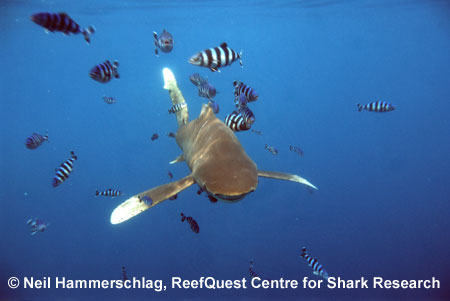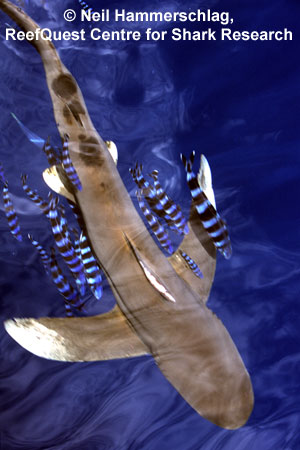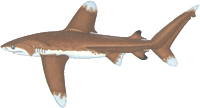Open Ocean: the Blue Desert
Oceanic Whitetip Shark
Referred to as the “Lord of the Long Hands” by pioneer undersea explorer Jacques Cousteau, the Oceanic Whitetip Shark (Carcharhinus longimanus) is among the most abundant large animals on Earth. This highly opportunistic species is remarkably quick to investigate potential food sources, including any unusual activity, whale carcasses, flotsam or jetsam. The Oceanic Whitetip is also frighteningly bold and persistent in testing the defenses of humans who — by accident or design — are plunked into its vast deepwater realm.
Just the Facts:
Size:
Reproduction:
Diet:
Habitat: Rocky Reefs, Coral Reefs, Open Ocean Depth: surface to at least 500 ft (150 m) Distribution: Central Pacific, Tropical Eastern Pacific, Chilean, North Atlantic, South Atlantic, Western North Atlantic, Caribbean, Amazonian, Argentinean, Eastern North Atlantic/Mediterranean, West African, Southern African, Central South Indian, Madagascaran, Arabian, Indian, South East Asian, Western Australian, Southeast Australian/New Zealand, Northern Australian, Japanese |
Like any ruler, the Oceanic Whitetip is often attended by an entourage of lesser creatures. These include tiny copepod parasites, which attach to the shark’s skin and feed on its blood, and a variety of pelagic fishes. Among the most peculiar of the fishes are slate-grey Remoras (Remora remora), which hitch a ride on Oceanic Whitetips by adhering with specialized sucker discs and earn their keep by feeding on their hosts’ copepod parasites. Boldly barred Pilotfishes (Naucrates ductor) perform no such service for their shark, but benefit only themselves by scavenging meal scraps and deriving protection by associating with their fearsome host. Perhaps the most surprising of the Oceanic Whitetips’ traveling companions are the spectacularly beautiful Dolphinfish (Coryphaena hipparus): these gorgeous, green and gold fishes are a common component in the diet of Oceanic Whitetips.
The Oceanic Whitetip Shark has broadly triangular, serrated upper teeth with overlapping bases and narrow-cusped lower teeth that are serrated at the tips. As befits an opportunistic open ocean predator, such teeth afford the Oceanic Whitetip a very broad dietary spectrum — able to tackle everything from small schooling fishes and Pelagic Stingrays (Pteroplatytrygon violacea), to inedible rubbish and huge, decomposing whale carcasses. However, examination of Oceanic Whitetips’ stomach contents has shown that they feed primarily on pelagic squids and fishes, including lancetfishes, oarfishes, barracudas, tunas and marlins.
It has long been a mystery how this apparently sluggish shark manages to capture such fast-swimming prey. An intriguing theory is that, under low ambient light conditions, the Oceanic Whitetip’s pale fin markings — all clearly moving together, while the rest of the shark is indistinct — may appear to be a small school of baitfish. This false ‘school’ might lure fast-swimming predatory fishes, such as tunas and marlins, close enough to a hunting Oceanic Whitetip to allow it to launch a surprise attack. I have seen this effect in the wild, and can attest that the pale tips of an Oceanic Whitetip’s first dorsal, pectoral, pelvic and caudal fins are quite conspicuous even when the remainder of the shark is indistinct or invisible.
Oceanic Whitetips often travel with female Short-Finned Pilot Whales (Globicephala macrorhynchus). Underwater observation has revealed that the sharks dive with the whales to depths of up to 2,000 feet (600 metres) and return with them to near the surface. It has been suggested that these Oceanic Whitetips rely on the Pilot Whales’ echolocation abilities to find schools of squid. This is certainly possible. But the sharks’ similar size and coloration to female Pilot Whales raises another possibility. Since the whales would not represent a threat to tunas and marlins (which also prey heavily on squids), individual Oceanic Whitetips may hide behind the bodies of female Pilot Whales as a kind of ‘moving blind’. This strategy would enable these deceptively slow-swimming sharks to get close to speedy prey that they otherwise might not and ambush them.

Both the ‘false school’ and ‘moving blind’ hypotheses feature ambush as a key ingredient. In the open ocean, ambush is difficult to achieve — there is nowhere for prey to hide from predators and virtually no way for predators to sneak up on prey. The sheer vastness of the open ocean provides some protection, as both predator and prey represent a minuscule blob of living protein somewhere in an unimaginable expanse of water. In practice, it is only slightly harder for a predator to locate an individual prey animal than an entire school. Even a whale carcass, enormous by human standards, is dwarfed by the mind-staggering enormity of the open ocean. Yet a whale carcass represents a tremendous caloric windfall — if it can be located before countless competitors beat one to it.
Like other sharks, the Oceanic Whitetip possesses a phenomenally acute sense of smell. The chemically-sensitive tissue of a shark’s nares is contained within a pair of capsules that open to the sea about mid-way along the undersurface of its snout. The flow of scent-bearing water into and out of these capsules is controlled by a flap of skin. Within each of these capsules, the actual olfactory epithelium is packed into a roughly spherical organ composed of a series of closely-spaced plates called “Schneiderian folds”. These plates serve to greatly increase the surface area of chemically-sensitive tissue within a relatively small, compact space.
Currents in the sea transport dissolved chemicals away from their source relatively slowly. But certain compounds, such as volatile oils that often indicate a rich food source, can be rapidly carried long distances by wind. A recent Russian study has demonstrated that the Schneiderian folds of the Oceanic Whitetip are closely spaced in such away that they can capture air bubbles at the surface. The study also showed that the Schneiderian folds of the Spiny Dogfish (Squalus acanthias) are spaced too far apart to trap surface air bubbles. The Spiny Dogfish is a bottom-dwelling species that rarely approaches the surface, so the ability to sniff bubbles is ecologically out-of-context for them. In contrast, Oceanic Whitetips, have repeatedly been observed holding their snout tips above the sea surface for several seconds at a time. The ability to sample the air chemically may enable these sharks to locate the source of an attractive odor more quickly than species that cannot. This would give the Oceanic Whitetip a major competitive advantage over other sharks in the otherwise featureless expanse of the open sea.
Although Oceanic Whitetip Sharks are equipped to feed upon virtually anything they find in the open ocean, they are not without predators themselves. The reason that these sharks are rarely, if ever, observed with male Short-Finned Pilot Whales may be that these toothy carnivores can reach lengths in excess of 21 feet (6.5 metres) and a mass of more than 8,000 pounds (3,600 kilograms), so they could easily make a meal of even a full-grown Oceanic Whitetip. Young Oceanic Whitetips may be vulnerable to almost any large, open ocean carnivore — including toothed whales, tunas and billfishes.
 A strange fact about newborn Oceanic Whitetips concerns their
pigmentation. From the time they are born until they reach a length of
about 4 feet (1.2 metres), these sharks show a remarkable reversal of the
usual fin tip pigmentation pattern. They still possess the broadly rounded
first dorsal and long, paddle-like pectoral fins that characterize their
species, but all their fin tips are black to dusky rather than mottled
whitish.
A strange fact about newborn Oceanic Whitetips concerns their
pigmentation. From the time they are born until they reach a length of
about 4 feet (1.2 metres), these sharks show a remarkable reversal of the
usual fin tip pigmentation pattern. They still possess the broadly rounded
first dorsal and long, paddle-like pectoral fins that characterize their
species, but all their fin tips are black to dusky rather than mottled
whitish.
I suspect that this reversal of apical pigmentation may be an anti-predator strategy, rendering the Oceanic Whitetip less conspicuous during the most vulnerable stage of their lives. But this is pure speculation on my part. The functional significance of the Oceanic Whitetip Shark’s two distinct pigmentation patterns — if there is one — remains a mystery, like much of the open ocean itself.
Oceanic Whitetip Shark Bibliography
More about: Scent Tracking in Sharks

